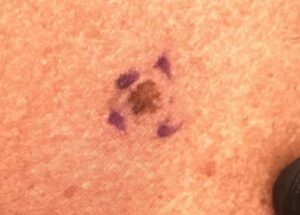15 Aug Which Skin Lesions & Growths Could be Cancerous?
Skin lesions are any area of your skin that’s abnormal from the skin around it, which can include skin growths, such as moles and warts, or even acne. Skin lesions are common and are often the result of an injury or damage to your skin, but some have the potential to be cancerous.
Skin cancers can arise from various types of skin lesions and growths. Some of the potential cancerous skin lesions and growths include:

- Melanoma: Melanoma is a type of skin cancer that develops from melanocytes, the cells that produce skin pigment (melanin). It often appears as a new or changing mole, with irregular borders, uneven coloration, and a larger size compared to other moles.

- Basal Cell Carcinoma (BCC): BCC is the most common type of skin cancer. It often appears as a pearly or waxy bump, or a flat, flesh-colored or brown scar-like lesion. BCC tends to grow slowly and is usually found on sun-exposed areas of the skin.

- Squamous Cell Carcinoma (SCC): SCC is another common type of skin cancer. It often appears as a firm, red nodule or a scaly, crusted patch. It may also be tender to the touch and can develop on areas frequently exposed to the sun.

- Actinic Keratosis: Also known as solar keratosis, these are rough, scaly patches on the skin that are often a result of prolonged sun exposure. While most actinic keratoses are not cancerous, some can progress to SCC if left untreated.
- Dysplastic Nevi: These are atypical moles that can resemble melanoma. They often have irregular borders, varied colors, and a larger size. While most dysplastic nevi are benign, some may increase the risk of melanoma.
- Merkel Cell Carcinoma: This is a rare and aggressive type of skin cancer that often appears as a firm, shiny nodule on the skin. It can be skin-colored, red, or blue.
- Kaposi’s Sarcoma: This cancer often appears as lesions on the skin, mouth, or internal organs. It is more commonly seen in people with weakened immune systems, such as those with HIV/AIDS.
- Sebaceous Carcinoma: This is a rare and aggressive cancer that usually arises from the oil glands in the skin. It can look like a painless lump or ulcer on the eyelid or other areas of the body.
Many skin lesions and growths are benign (non-cancerous) and may not require treatment. However, it’s important to have any new or changing skin lesions examined by a qualified dermatologist or healthcare professional. They can provide proper diagnosis and recommend appropriate treatments if necessary.
Early detection and treatment are key to successful outcomes in cases of skin cancer. If you or someone you care about are worried about a skin lesion or growth, give us a call and schedule a skin screening.


